VOLKSWAGEN UP! 2021 Owner´s Manual
Manufacturer: VOLKSWAGEN, Model Year: 2021, Model line: UP!, Model: VOLKSWAGEN UP! 2021Pages: 211, PDF Size: 5.98 MB
Page 51 of 211
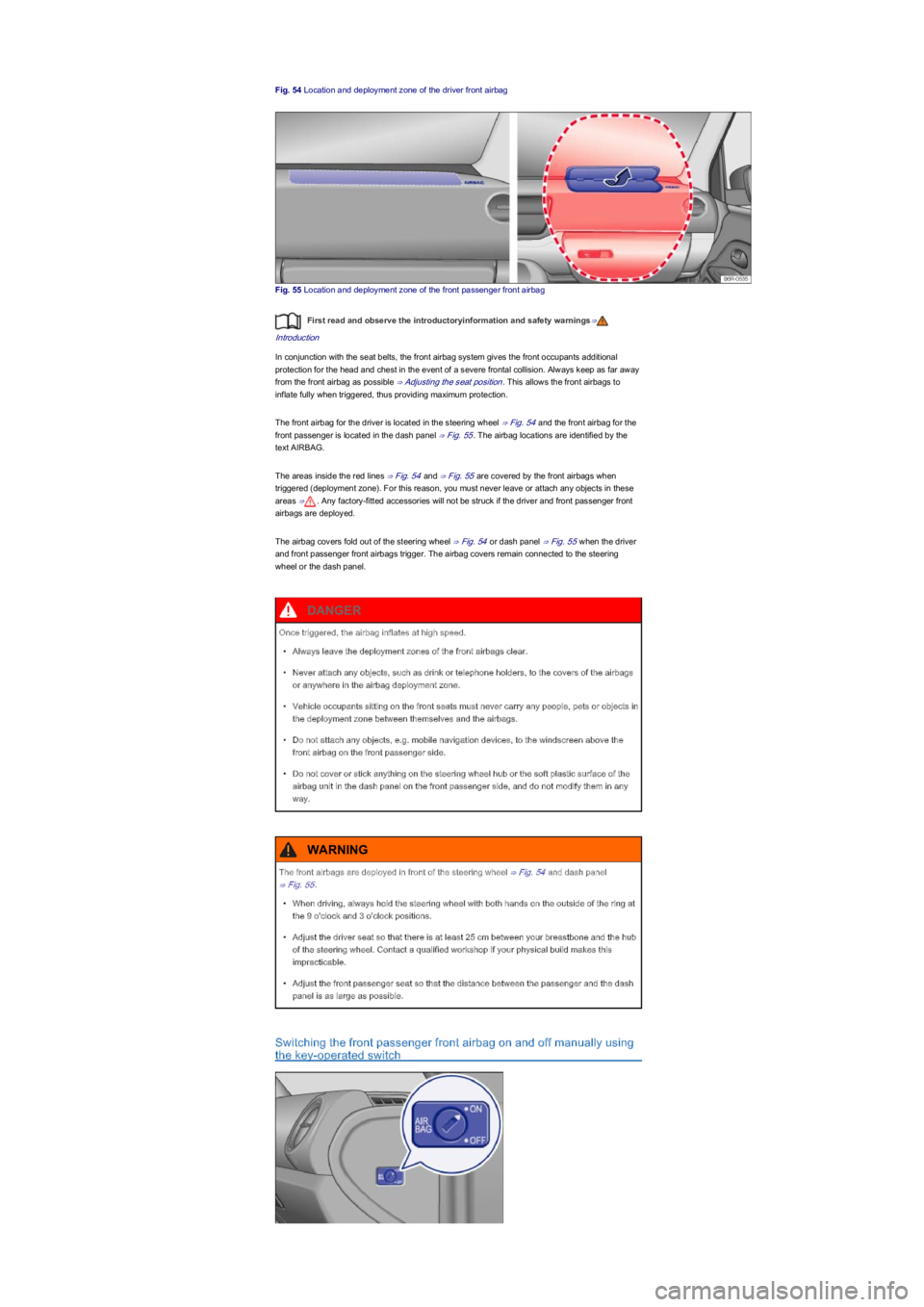
Fig. 54 Location and deployment zone of the driver front airbag
Fig. 55 Location and deployment zone of the front passenger front airbag
First read and observe the introductoryinformation and safety warnings⇒
Introduction
In conjunction with the seat belts, the front airbag system gives the front occupants additional
protection for the head and chest in the event of a severe frontal collision. Always keep as far away
from the front airbag as possible ⇒ Adjusting the seat position. This allows the front airbags to
inflate fully when triggered, thus providing maximum protection.
The front airbag for the driver is located in the steering wheel ⇒ Fig. 54 and the front airbag for the
front passenger is located in the dash panel ⇒ Fig. 55. The airbag locations are identified by the
text AIRBAG.
The areas inside the red lines ⇒ Fig. 54 and ⇒ Fig. 55 are covered by the front airbags when
triggered (deployment zone). For this reason, you must never leave or attach any objects in these
areas ⇒. Any factory-fitted accessories will not be struck if the driver and front passenger front
airbags are deployed.
The airbag covers fold out of the steering wheel ⇒ Fig. 54 or dash panel ⇒ Fig. 55 when the driver
and front passenger front airbags trigger. The airbag covers remain connected to the steering
wheel or the dash panel.
Switching the front passenger front airbag on and off manually using
the key-operated switch
Once triggered, the airbag inflates at high speed.
•Always leave the deployment zones of the front airbags clear.
•Never attach any objects, such as drink or telephone holders, to the covers of the airbags
or anywhere in the airbag deployment zone.
•Vehicle occupants sitting on the front seats must never carry any people, pets or objects in
the deployment zone between themselves and the airbags.
•Do not attach any objects, e.g. mobile navigation devices, to the windscreen above the
front airbag on the front passenger side.
•Do not cover or stick anything on the steering wheel hub or the soft plastic surface of the
airbag unit in the dash panel on the front passenger side, and do not modify them in any
way.
DANGER
The front airbags are deployed in front of the steering wheel ⇒ Fig. 54 and dash panel
⇒ Fig. 55.
•When driving, always hold the steering wheel with both hands on the outside of the ring at
the 9 o'clock and 3 o'clock positions.
•Adjust the driver seat so that there is at least 25 cm between your breastbone and the hub
of the steering wheel. Contact a qualified workshop if your physical build makes this
impracticable.
•Adjust the front passenger seat so that the distance between the passenger and the dash
panel is as large as possible.
WARNING
Page 52 of 211
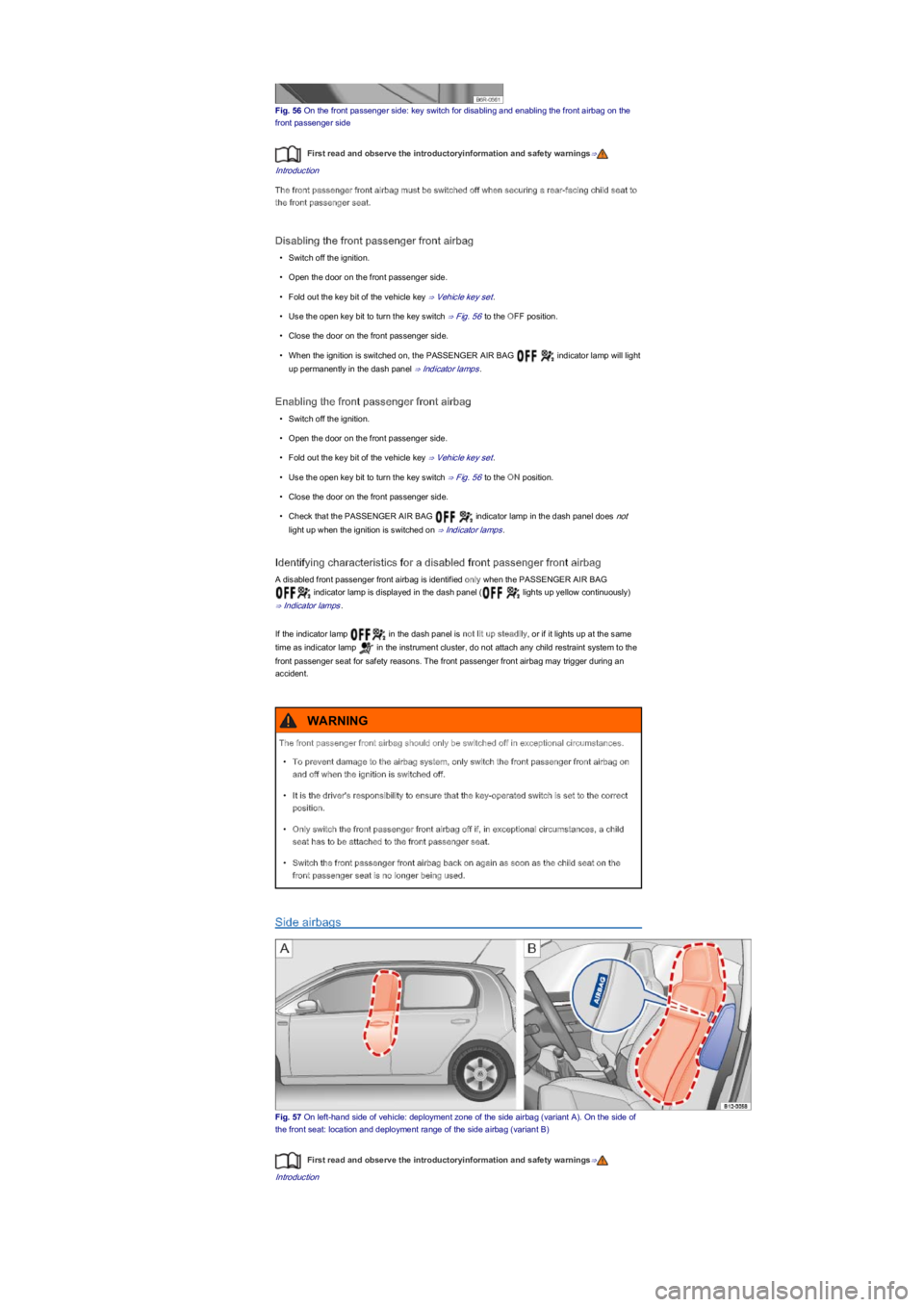
Fig. 56 On the front passenger side: key switch for disabling and enabling the front airbag on the
front passenger side
First read and observe the introductoryinformation and safety warnings⇒
Introduction
The front passenger front airbag must be switched off when securing a rear-facing child seat to
the front passenger seat.
Disabling the front passenger front airbag
•Switch off the ignition.
•Open the door on the front passenger side.
•Fold out the key bit of the vehicle key ⇒ Vehicle key set.
•Use the open key bit to turn the key switch ⇒ Fig. 56 to the OFF position.
•Close the door on the front passenger side.
•When the ignition is switched on, the PASSENGER AIR BAG indicator lamp will light
up permanently in the dash panel ⇒ Indicator lamps.
Enabling the front passenger front airbag
•Switch off the ignition.
•Open the door on the front passenger side.
•Fold out the key bit of the vehicle key ⇒ Vehicle key set.
•Use the open key bit to turn the key switch ⇒ Fig. 56 to the ON position.
•Close the door on the front passenger side.
•Check that the PASSENGER AIR BAG indicator lamp in the dash panel does not
light up when the ignition is switched on ⇒ Indicator lamps.
Identifying characteristics for a disabled front passenger front airbag
A disabled front passenger front airbag is identified only when the PASSENGER AIR BAG
indicator lamp is displayed in the dash panel ( lights up yellow continuously)
⇒ Indicator lamps.
If the indicator lamp in the dash panel is not lit up steadily, or if it lights up at the same
time as indicator lamp in the instrument cluster, do not attach any child restraint system to the
front passenger seat for safety reasons. The front passenger front airbag may trigger during an
accident.
Side airbags
Fig. 57 On left-hand side of vehicle: deployment zone of the side airbag (variant A). On the side of
the front seat: location and deployment range of the side airbag (variant B)
First read and observe the introductoryinformation and safety warnings⇒
Introduction
The front passenger front airbag should only be switched off in exceptional circumstances.
•To prevent damage to the airbag system, only switch the front passenger front airbag on
and off when the ignition is switched off.
•It is the driver's responsibility to ensure that the key-operated switch is set to the correct
position.
•Only switch the front passenger front airbag off if, in exceptional circumstances, a child
seat has to be attached to the front passenger seat.
•Switch the front passenger front airbag back on again as soon as the child seat on the
front passenger seat is no longer being used.
WARNING
Page 53 of 211
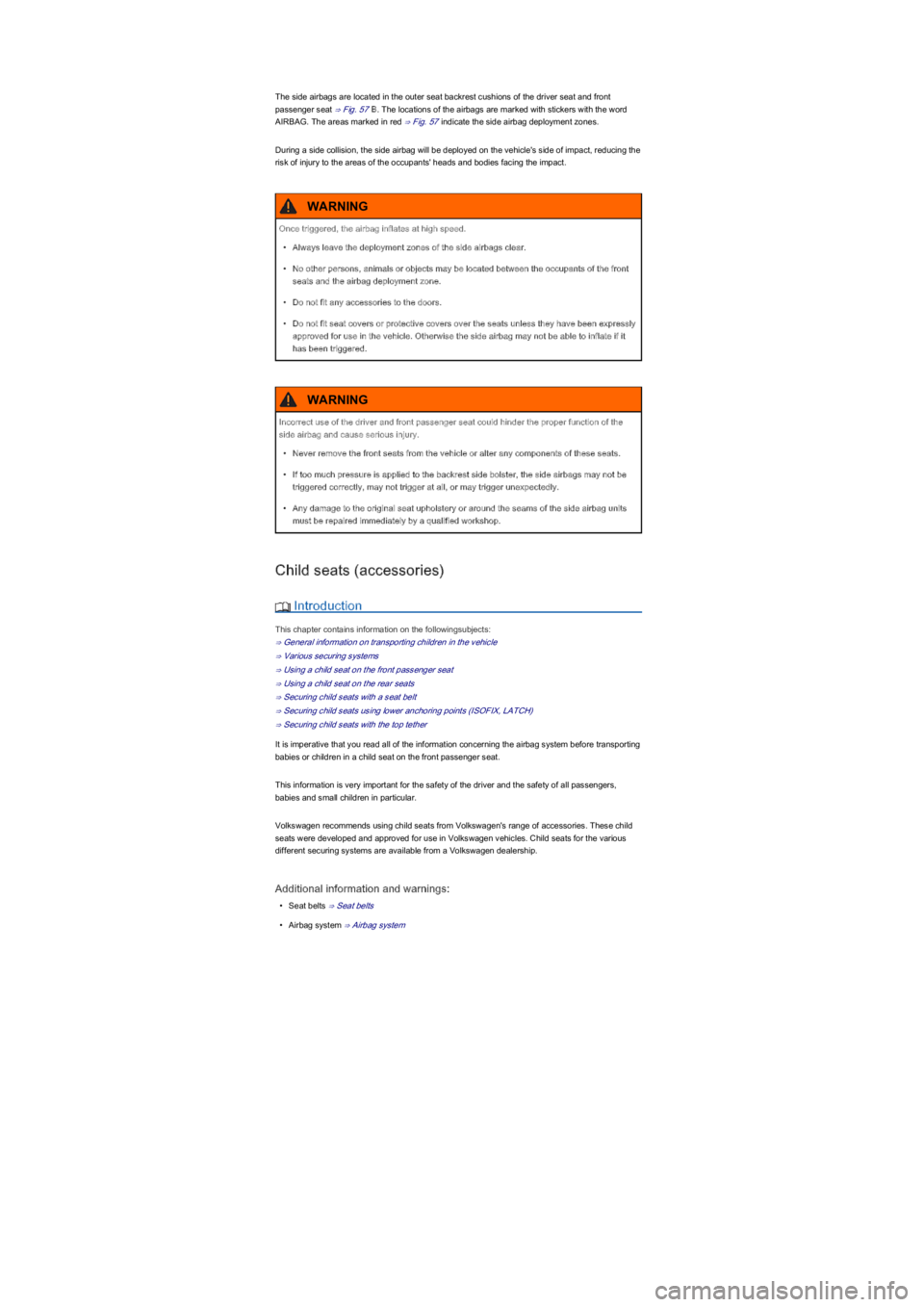
The side airbags are located in the outer seat backrest cushions of the driver seat and front
passenger seat ⇒ Fig. 57B. The locations of the airbags are marked with stickers with the word
AIRBAG. The areas marked in red ⇒ Fig. 57 indicate the side airbag deployment zones.
During a side collision, the side airbag will be deployed on the vehicle's side of impact, reducing the
risk of injury to the areas of the occupants' heads and bodies facing the impact.
Child seats (accessories)
Introduction
This chapter contains information on the followingsubjects:
⇒ General information on transporting children in the vehicle
⇒ Various securing systems
⇒ Using a child seat on the front passenger seat
⇒ Using a child seat on the rear seats
⇒ Securing child seats with a seat belt
⇒ Securing child seats using lower anchoring points (ISOFIX, LATCH)
⇒ Securing child seats with the top tether
It is imperative that you read all of the information concerning the airbag system before transporting
babies or children in a child seat on the front passenger seat.
This information is very important for the safety of the driver and the safety of all passengers,
babies and small children in particular.
Volkswagen recommends using child seats from Volkswagen's range of accessories. These child
seats were developed and approved for use in Volkswagen vehicles. Child seats for the various
different securing systems are available from a Volkswagen dealership.
Additional information and warnings:
•Seat belts ⇒ Seat belts
•Airbag system ⇒ Airbag system
Once triggered, the airbag inflates at high speed.
•Always leave the deployment zones of the side airbags clear.
•No other persons, animals or objects may be located between the occupants of the front
seats and the airbag deployment zone.
•Do not fit any accessories to the doors.
•Do not fit seat covers or protective covers over the seats unless they have been expressly
approved for use in the vehicle. Otherwise the side airbag may not be able to inflate if it
has been triggered.
WARNING
Incorrect use of the driver and front passenger seat could hinder the proper function of the
side airbag and cause serious injury.
•Never remove the front seats from the vehicle or alter any components of these seats.
•If too much pressure is applied to the backrest side bolster, the side airbags may not be
triggered correctly, may not trigger at all, or may trigger unexpectedly.
•Any damage to the original seat upholstery or around the seams of the side airbag units
must be repaired immediately by a qualified workshop.
WARNING
Page 54 of 211

Comply with any country-specific legal regulations.
Volkswagen recommends that children under 12 years of age are always transported on
the rear seats.
A child should only be transported on the front passenger seat in exceptional
circumstances Using a child seat on the front passenger seat. The safest seat in the
vehicle is on the rear seat behind the front passenger seat.
Always secure any children in the vehicle in a restraint system. The restraint system must
be suitable for the child's height, weight and build.
Transport only one child per child seat.
Observe the instructions from the manufacturer of the child seat and always keep them in
the vehicle.
When securing a child seat using the seat belt, always guide the belt through or around
the child seat as described in the instructions from the child seat manufacturer.
Always ensure that the seat belt routing is correct for children and that they are sitting in
the correct position.
Whenever possible, fit the child seat on the rear bench seat behind the front passenger
seat so that children can exit the vehicle on the kerb side.
Replace child seats that withstand any force during an accident as they could have
sustained damage that may not be visible.
General information on transporting children in the vehicle
First read and observe the introductoryinformation and safety warnings⇒
Introduction
Legislation and legal requirements take precedence over the descriptions in this owner's manual.
Various standards and regulations govern the use of child seats and methods for securing them ().
For example, this could mean that in some countries you are not allowed to use child seats on
certain seats in the vehicle.
The laws of physics, which come into force on a vehicle during a collision or any other kind of
accident, also apply to children ⇒ Seat belts. In contrast to adults and teenagers, however,
children's muscles and bones are not yet fully developed. There is a higher risk for children than for
adults of sustaining serious injuries in an accident.
Children must be transported using child restraint systems that are specifically suited to their size,
weight and physical build, as children's bodies are not yet fully developed. In many countries there
are laws that require the use of approved child restraint systems for babies and small children.
Only use suitable, approved and authorised child seats in your vehicle. If you are unsure, always
speak to your Volkswagen dealership or a qualified workshop.
Checklist
Transporting children in the vehicle ⇒:
Children who are not strapped in or who are not strapped in properly could sustain severe or
fatal injuries while the vehicle is in motion.
•Never use a rear-facing child seat on the front passenger seat when the front passenger
front airbag is switched on.
•Children up to 12 years of age should always be transported on the rear seat.
•Always secure children in the vehicle in an authorised restraint system suitable for their
height and weight.
•Always fasten children's seat belts correctly and ensure that they assume a correct sitting
position.
•Adjust the seat backrest to an upright position if a child seat is to be used on this seat.
•Do not allow children to sit with their heads or any other body parts in the deployment
zone of the side airbag.
•Ensure that the seat belt routing is correct.
•Never allow children or babies to be transported on someone's lap, or while being held.
•Only ever fasten one child into each child seat.
•Read and follow the instructions by the manufacturer of the child seat.
WARNING
An unsecured, unoccupied child seat can be flung through the vehicle interior in the event of a
sudden braking manoeuvre or accident and cause injuries.
•Always secure child seats safely or stow them in the luggage compartment if they are not
being used while the vehicle is in motion.
WARNING
Page 55 of 211
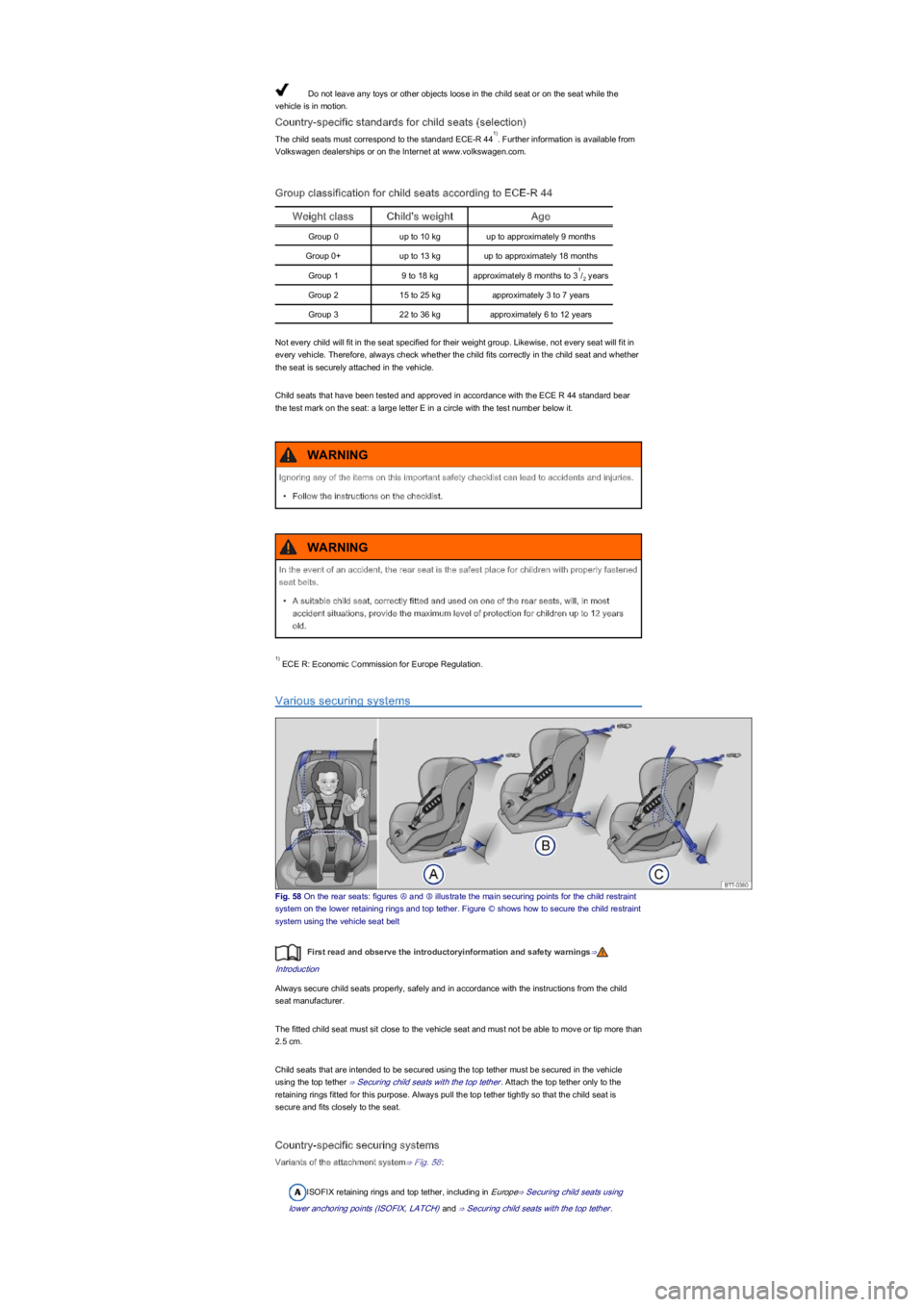
Do not leave any toys or other objects loose in the child seat or on the seat while the
vehicle is in motion.
Country-specific standards for child seats (selection)
The child seats must correspond to the standard ECE-R 44. Further information is available from
Volkswagen dealerships or on the Internet at www.volkswagen.com.
Group classification for child seats according to ECE-R 44
Weight classChild's weightAge
Group 0up to 10 kgup to approximately 9 months
Group 0+up to 13 kgup to approximately 18 months
Group 19 to 18 kgapproximately 8 months to 3/ years
Group 215 to 25 kgapproximately 3 to 7 years
Group 322 to 36 kgapproximately 6 to 12 years
Not every child will fit in the seat specified for their weight group. Likewise, not every seat will fit in
every vehicle. Therefore, always check whether the child fits correctly in the child seat and whether
the seat is securely attached in the vehicle.
Child seats that have been tested and approved in accordance with the ECE R 44 standard bear
the test mark on the seat: a large letter E in a circle with the test number below it.
ECE R: Economic Commission for Europe Regulation.
Various securing systems
Fig. 58 On the rear seats: figures Ⓐ and Ⓑ illustrate the main securing points for the child restraint
system on the lower retaining rings and top tether. Figure Ⓒ shows how to secure the child restraint
system using the vehicle seat belt
First read and observe the introductoryinformation and safety warnings⇒
Introduction
Always secure child seats properly, safely and in accordance with the instructions from the child
seat manufacturer.
The fitted child seat must sit close to the vehicle seat and must not be able to move or tip more than
2.5 cm.
Child seats that are intended to be secured using the top tether must be secured in the vehicle
using the top tether ⇒ Securing child seats with the top tether. Attach the top tether only to the
retaining rings fitted for this purpose. Always pull the top tether tightly so that the child seat is
secure and fits closely to the seat.
Country-specific securing systems
Variants of the attachment system⇒ Fig. 58:
ISOFIX retaining rings and top tether, including in Europe⇒ Securing child seats using
lower anchoring points (ISOFIX, LATCH) and ⇒ Securing child seats with the top tether.
1)
1
2
Ignoring any of the items on this important safety checklist can lead to accidents and injuries.
•Follow the instructions on the checklist.
WARNING
In the event of an accident, the rear seat is the safest place for children with properly fastened
seat belts.
•A suitable child seat, correctly fitted and used on one of the rear seats, will, in most
accident situations, provide the maximum level of protection for children up to 12 years
old.
WARNING
1)
Page 56 of 211
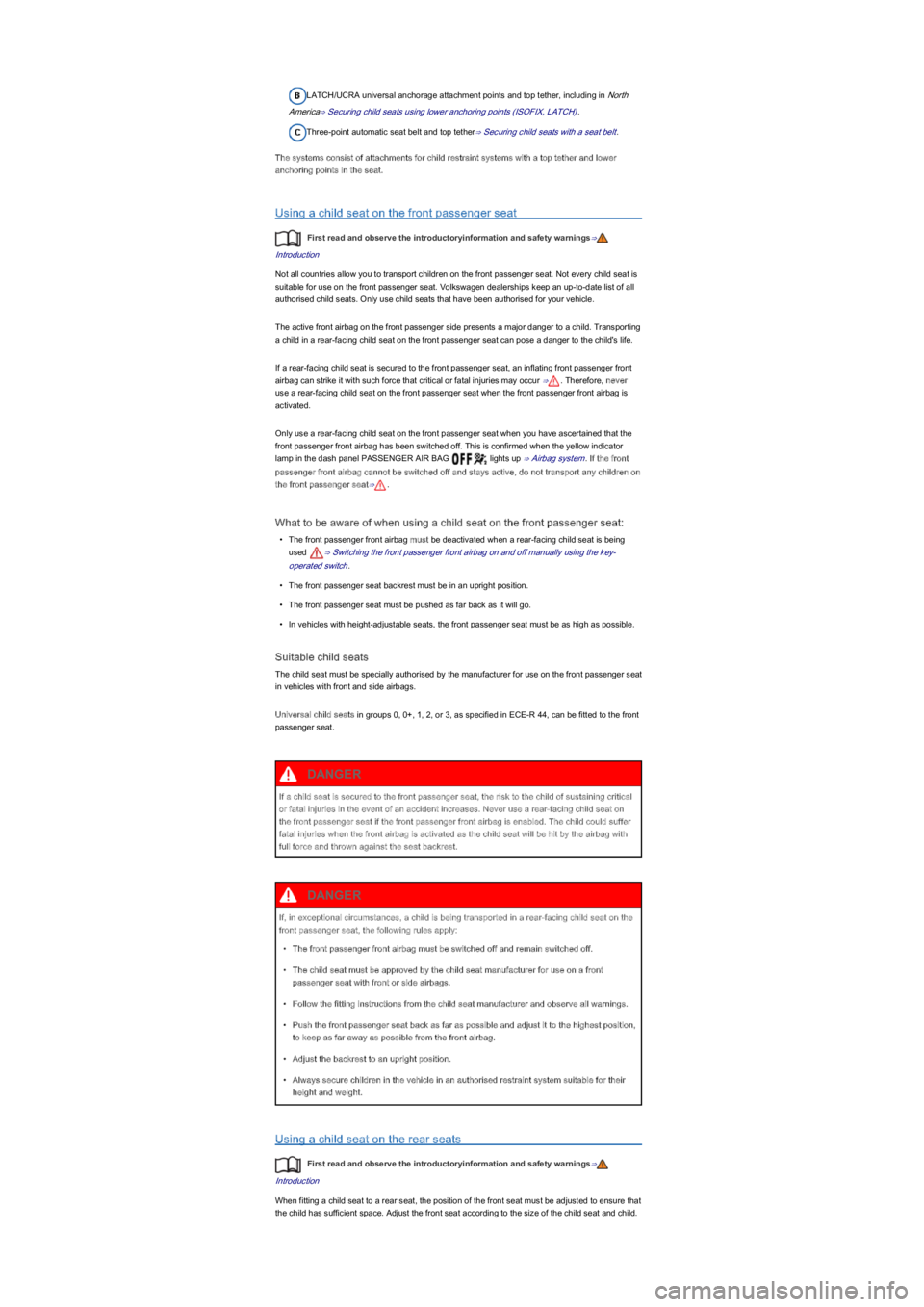
LATCH/UCRA universal anchorage attachment points and top tether, including in North
America⇒ Securing child seats using lower anchoring points (ISOFIX, LATCH).
Three-point automatic seat belt and top tether⇒ Securing child seats with a seat belt.
The systems consist of attachments for child restraint systems with a top tether and lower
anchoring points in the seat.
Using a child seat on the front passenger seat
First read and observe the introductoryinformation and safety warnings⇒
Introduction
Not all countries allow you to transport children on the front passenger seat. Not every child seat is
suitable for use on the front passenger seat. Volkswagen dealerships keep an up-to-date list of all
authorised child seats. Only use child seats that have been authorised for your vehicle.
The active front airbag on the front passenger side presents a major danger to a child. Transporting
a child in a rear-facing child seat on the front passenger seat can pose a danger to the child's life.
If a rear-facing child seat is secured to the front passenger seat, an inflating front passenger front
airbag can strike it with such force that critical or fatal injuries may occur ⇒. Therefore, never
use a rear-facing child seat on the front passenger seat when the front passenger front airbag is
activated.
Only use a rear-facing child seat on the front passenger seat when you have ascertained that the
front passenger front airbag has been switched off. This is confirmed when the yellow indicator
lamp in the dash panel PASSENGER AIR BAG lights up ⇒ Airbag system. If the front
passenger front airbag cannot be switched off and stays active, do not transport any children on
the front passenger seat⇒.
What to be aware of when using a child seat on the front passenger seat:
•The front passenger front airbag must be deactivated when a rear-facing child seat is being
used ⇒ Switching the front passenger front airbag on and off manually using the key-
operated switch.
•The front passenger seat backrest must be in an upright position.
•The front passenger seat must be pushed as far back as it will go.
•In vehicles with height-adjustable seats, the front passenger seat must be as high as possible.
Suitable child seats
The child seat must be specially authorised by the manufacturer for use on the front passenger seat
in vehicles with front and side airbags.
Universal child seats in groups 0, 0+, 1, 2, or 3, as specified in ECE-R 44, can be fitted to the front
passenger seat.
Using a child seat on the rear seats
First read and observe the introductoryinformation and safety warnings⇒
Introduction
When fitting a child seat to a rear seat, the position of the front seat must be adjusted to ensure that
the child has sufficient space. Adjust the front seat according to the size of the child seat and child.
If a child seat is secured to the front passenger seat, the risk to the child of sustaining critical
or fatal injuries in the event of an accident increases. Never use a rear-facing child seat on
the front passenger seat if the front passenger front airbag is enabled. The child could suffer
fatal injuries when the front airbag is activated as the child seat will be hit by the airbag with
full force and thrown against the seat backrest.
DANGER
If, in exceptional circumstances, a child is being transported in a rear-facing child seat on the
front passenger seat, the following rules apply:
•The front passenger front airbag must be switched off and remain switched off.
•The child seat must be approved by the child seat manufacturer for use on a front
passenger seat with front or side airbags.
•Follow the fitting instructions from the child seat manufacturer and observe all warnings.
•Push the front passenger seat back as far as possible and adjust it to the highest position,
to keep as far away as possible from the front airbag.
•Adjust the backrest to an upright position.
•Always secure children in the vehicle in an authorised restraint system suitable for their
height and weight.
DANGER
Page 57 of 211
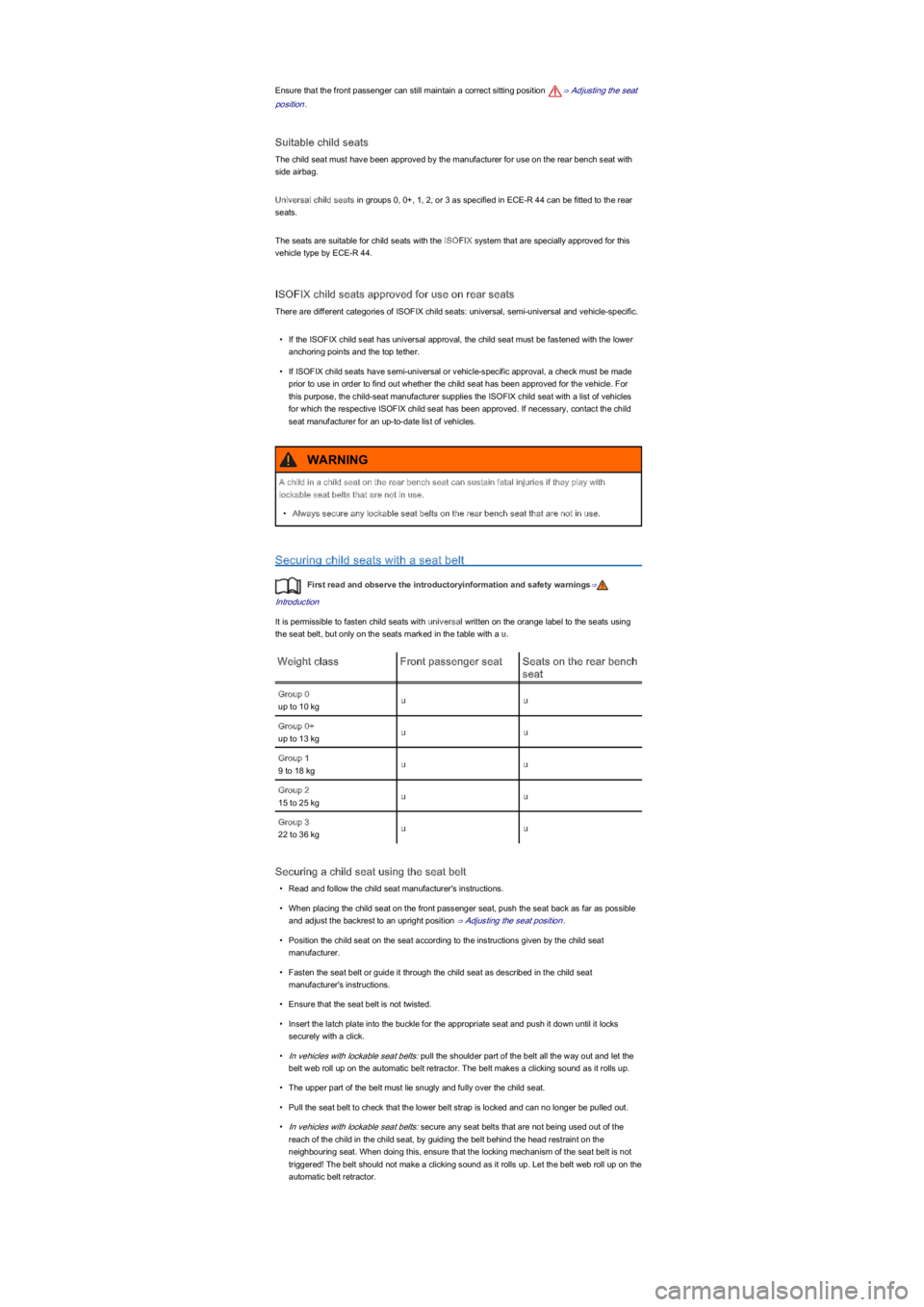
Ensure that the front passenger can still maintain a correct sitting position ⇒ Adjusting the seat
position.
Suitable child seats
The child seat must have been approved by the manufacturer for use on the rear bench seat with
side airbag.
Universal child seats in groups 0, 0+, 1, 2, or 3 as specified in ECE-R 44 can be fitted to the rear
seats.
The seats are suitable for child seats with the ISOFIX system that are specially approved for this
vehicle type by ECE-R 44.
ISOFIX child seats approved for use on rear seats
There are different categories of ISOFIX child seats: universal, semi-universal and vehicle-specific.
•If the ISOFIX child seat has universal approval, the child seat must be fastened with the lower
anchoring points and the top tether.
•If ISOFIX child seats have semi-universal or vehicle-specific approval, a check must be made
prior to use in order to find out whether the child seat has been approved for the vehicle. For
this purpose, the child-seat manufacturer supplies the ISOFIX child seat with a list of vehicles
for which the respective ISOFIX child seat has been approved. If necessary, contact the child
seat manufacturer for an up-to-date list of vehicles.
Securing child seats with a seat belt
First read and observe the introductoryinformation and safety warnings⇒
Introduction
It is permissible to fasten child seats with universal written on the orange label to the seats using
the seat belt, but only on the seats marked in the table with a u.
Weight classFront passenger seatSeats on the rear bench
seat
Group 0
up to 10 kguu
Group 0+
up to 13 kguu
Group 1
9 to 18 kguu
Group 2
15 to 25 kguu
Group 3
22 to 36 kguu
Securing a child seat using the seat belt
•Read and follow the child seat manufacturer's instructions.
•When placing the child seat on the front passenger seat, push the seat back as far as possible
and adjust the backrest to an upright position ⇒ Adjusting the seat position.
•Position the child seat on the seat according to the instructions given by the child seat
manufacturer.
•Fasten the seat belt or guide it through the child seat as described in the child seat
manufacturer's instructions.
•Ensure that the seat belt is not twisted.
•Insert the latch plate into the buckle for the appropriate seat and push it down until it locks
securely with a click.
•In vehicles with lockable seat belts: pull the shoulder part of the belt all the way out and let the
belt web roll up on the automatic belt retractor. The belt makes a clicking sound as it rolls up.
•The upper part of the belt must lie snugly and fully over the child seat.
•Pull the seat belt to check that the lower belt strap is locked and can no longer be pulled out.
•In vehicles with lockable seat belts: secure any seat belts that are not being used out of the
reach of the child in the child seat, by guiding the belt behind the head restraint on the
neighbouring seat. When doing this, ensure that the locking mechanism of the seat belt is not
triggered! The belt should not make a clicking sound as it rolls up. Let the belt web roll up on the
automatic belt retractor.
A child in a child seat on the rear bench seat can sustain fatal injuries if they play with
lockable seat belts that are not in use.
•Always secure any lockable seat belts on the rear bench seat that are not in use.
WARNING
Page 58 of 211
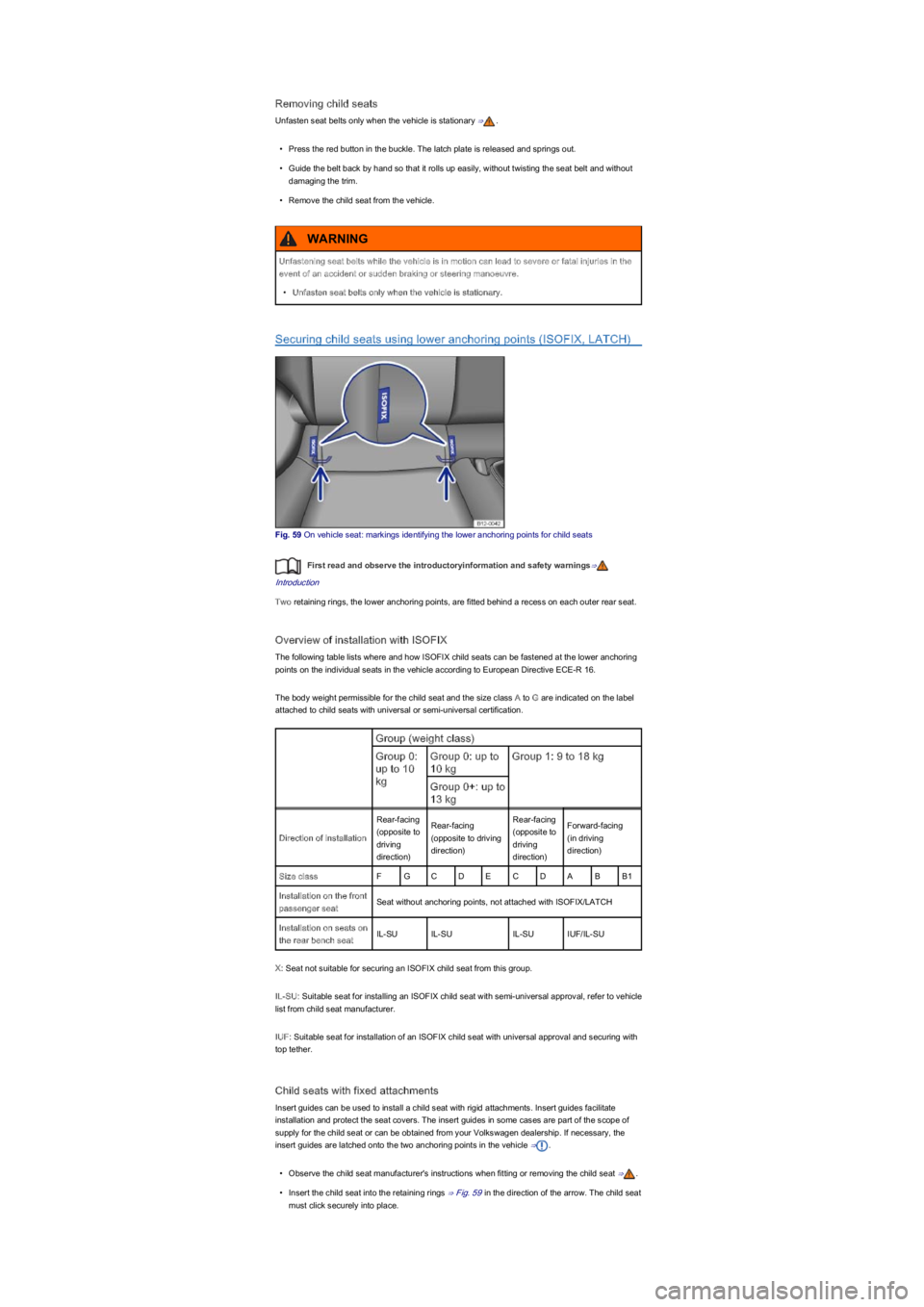
Removing child seats
Unfasten seat belts only when the vehicle is stationary ⇒.
•Press the red button in the buckle. The latch plate is released and springs out.
•Guide the belt back by hand so that it rolls up easily, without twisting the seat belt and without
damaging the trim.
•Remove the child seat from the vehicle.
Securing child seats using lower anchoring points (ISOFIX, LATCH)
Fig. 59 On vehicle seat: markings identifying the lower anchoring points for child seats
First read and observe the introductoryinformation and safety warnings⇒
Introduction
Two retaining rings, the lower anchoring points, are fitted behind a recess on each outer rear seat.
Overview of installation with ISOFIX
The following table lists where and how ISOFIX child seats can be fastened at the lower anchoring
points on the individual seats in the vehicle according to European Directive ECE-R 16.
The body weight permissible for the child seat and the size class A to G are indicated on the label
attached to child seats with universal or semi-universal certification.
Group (weight class)
Group 0:
up to 10
kg
Group 0: up to
10 kg
Group 1: 9 to 18 kg
Group 0+: up to
13 kg
Direction of installation
Rear-facing
(opposite to
driving
direction)
Rear-facing
(opposite to driving
direction)
Rear-facing
(opposite to
driving
direction)
Forward-facing
(in driving
direction)
Size classFGCDECDABB1
Installation on the front
passenger seatSeat without anchoring points, not attached with ISOFIX/LATCH
Installation on seats on
the rear bench seatIL-SUIL-SUIL-SUIUF/IL-SU
X: Seat not suitable for securing an ISOFIX child seat from this group.
IL-SU: Suitable seat for installing an ISOFIX child seat with semi-universal approval, refer to vehicle
list from child seat manufacturer.
IUF: Suitable seat for installation of an ISOFIX child seat with universal approval and securing with
top tether.
Child seats with fixed attachments
Insert guides can be used to install a child seat with rigid attachments. Insert guides facilitate
installation and protect the seat covers. The insert guides in some cases are part of the scope of
supply for the child seat or can be obtained from your Volkswagen dealership. If necessary, the
insert guides are latched onto the two anchoring points in the vehicle ⇒.
•Observe the child seat manufacturer's instructions when fitting or removing the child seat ⇒.
•Insert the child seat into the retaining rings ⇒ Fig. 59 in the direction of the arrow. The child seat
must click securely into place.
Unfastening seat belts while the vehicle is in motion can lead to severe or fatal injuries in the
event of an accident or sudden braking or steering manoeuvre.
•Unfasten seat belts only when the vehicle is stationary.
WARNING
Page 59 of 211
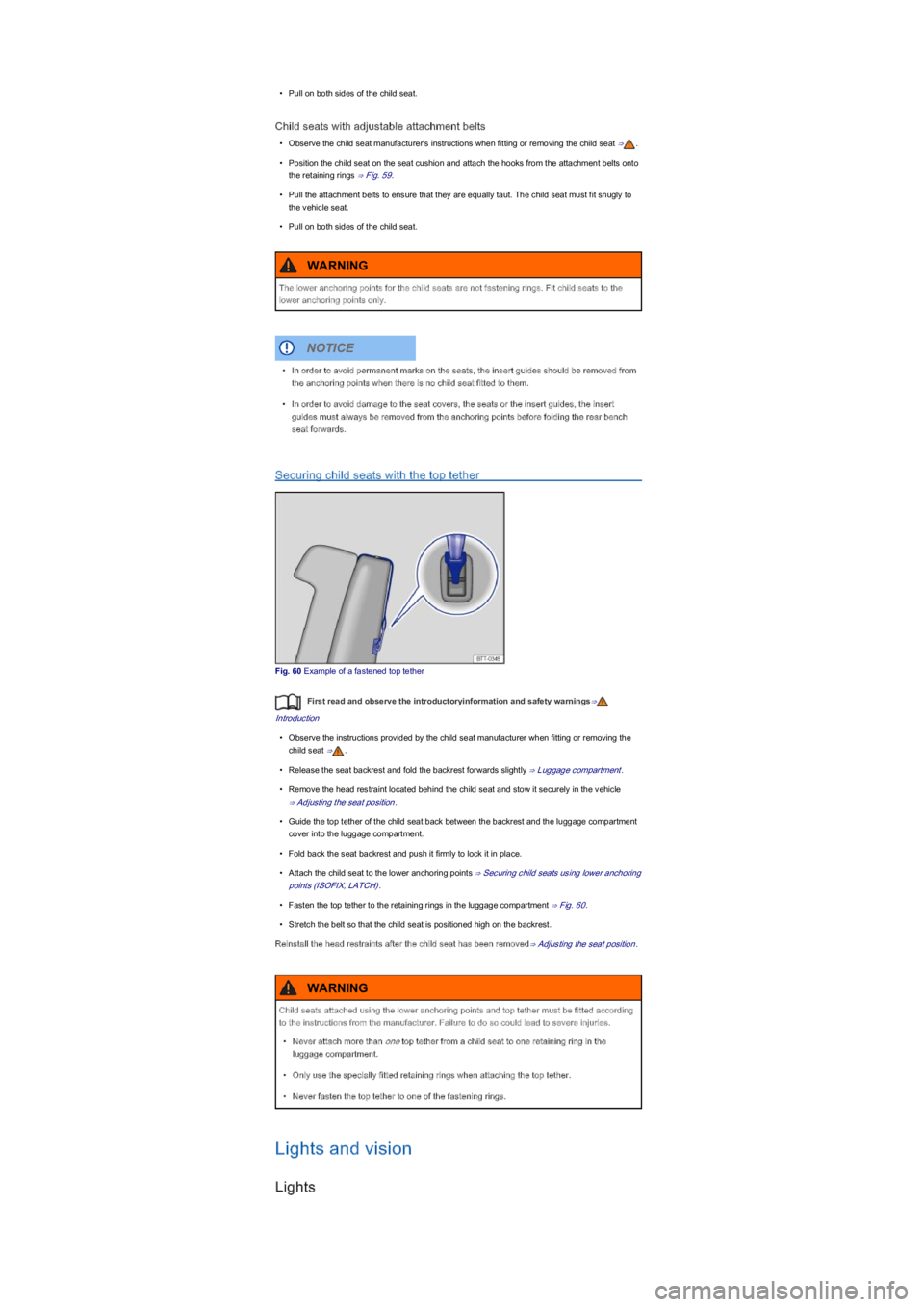
•Pull on both sides of the child seat.
Child seats with adjustable attachment belts
•Observe the child seat manufacturer's instructions when fitting or removing the child seat ⇒.
•Position the child seat on the seat cushion and attach the hooks from the attachment belts onto
the retaining rings ⇒ Fig. 59.
•Pull the attachment belts to ensure that they are equally taut. The child seat must fit snugly to
the vehicle seat.
•Pull on both sides of the child seat.
Securing child seats with the top tether
Fig. 60 Example of a fastened top tether
First read and observe the introductoryinformation and safety warnings⇒
Introduction
•Observe the instructions provided by the child seat manufacturer when fitting or removing the
child seat ⇒.
•Release the seat backrest and fold the backrest forwards slightly ⇒ Luggage compartment.
•Remove the head restraint located behind the child seat and stow it securely in the vehicle
⇒ Adjusting the seat position.
•Guide the top tether of the child seat back between the backrest and the luggage compartment
cover into the luggage compartment.
•Fold back the seat backrest and push it firmly to lock it in place.
•Attach the child seat to the lower anchoring points ⇒ Securing child seats using lower anchoring
points (ISOFIX, LATCH).
•Fasten the top tether to the retaining rings in the luggage compartment ⇒ Fig. 60.
•Stretch the belt so that the child seat is positioned high on the backrest.
Reinstall the head restraints after the child seat has been removed⇒ Adjusting the seat position.
Lights and vision
Lights
The lower anchoring points for the child seats are not fastening rings. Fit child seats to the
lower anchoring points only.
WARNING
•In order to avoid permanent marks on the seats, the insert guides should be removed from
the anchoring points when there is no child seat fitted to them.
•In order to avoid damage to the seat covers, the seats or the insert guides, the insert
guides must always be removed from the anchoring points before folding the rear bench
seat forwards.
NOTICE
Child seats attached using the lower anchoring points and top tether must be fitted according
to the instructions from the manufacturer. Failure to do so could lead to severe injuries.
•Never attach more than one top tether from a child seat to one retaining ring in the
luggage compartment.
•Only use the specially fitted retaining rings when attaching the top tether.
•Never fasten the top tether to one of the fastening rings.
WARNING
Page 60 of 211
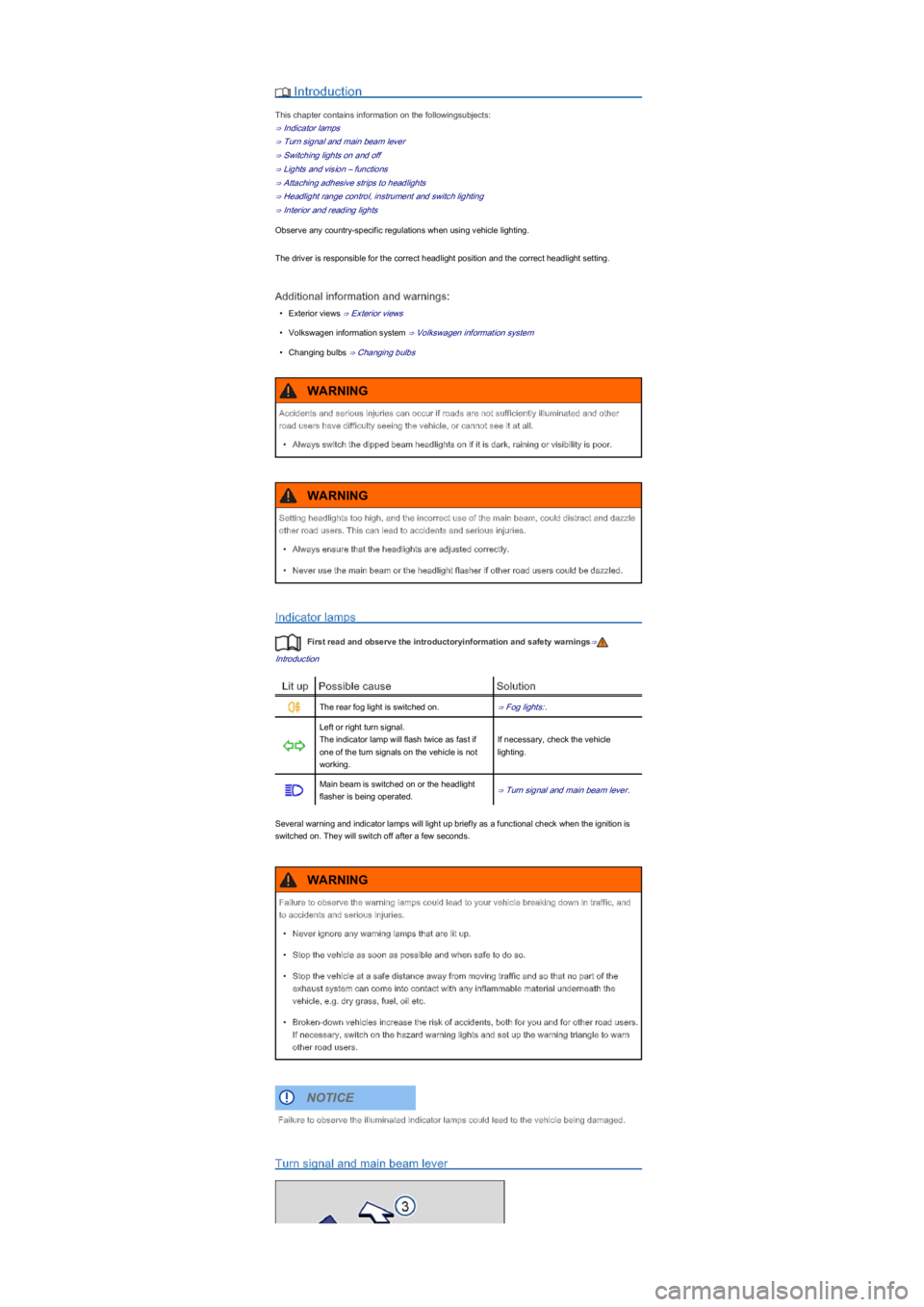
Introduction
This chapter contains information on the followingsubjects:
⇒ Indicator lamps
⇒ Turn signal and main beam lever
⇒ Switching lights on and off
⇒ Lights and vision – functions
⇒ Attaching adhesive strips to headlights
⇒ Headlight range control, instrument and switch lighting
⇒ Interior and reading lights
Observe any country-specific regulations when using vehicle lighting.
The driver is responsible for the correct headlight position and the correct headlight setting.
Additional information and warnings:
•Exterior views ⇒ Exterior views
•Volkswagen information system ⇒ Volkswagen information system
•Changing bulbs ⇒ Changing bulbs
Indicator lamps
First read and observe the introductoryinformation and safety warnings⇒
Introduction
Lit upPossible causeSolution
The rear fog light is switched on.⇒ Fog lights:.
Left or right turn signal.
The indicator lamp will flash twice as fast if
one of the turn signals on the vehicle is not
working.
If necessary, check the vehicle
lighting.
Main beam is switched on or the headlight
flasher is being operated.⇒ Turn signal and main beam lever.
Several warning and indicator lamps will light up briefly as a functional check when the ignition is
switched on. They will switch off after a few seconds.
Turn signal and main beam lever
Accidents and serious injuries can occur if roads are not sufficiently illuminated and other
road users have difficulty seeing the vehicle, or cannot see it at all.
•Always switch the dipped beam headlights on if it is dark, raining or visibility is poor.
WARNING
Setting headlights too high, and the incorrect use of the main beam, could distract and dazzle
other road users. This can lead to accidents and serious injuries.
•Always ensure that the headlights are adjusted correctly.
•Never use the main beam or the headlight flasher if other road users could be dazzled.
WARNING
Failure to observe the warning lamps could lead to your vehicle breaking down in traffic, and
to accidents and serious injuries.
•Never ignore any warning lamps that are lit up.
•Stop the vehicle as soon as possible and when safe to do so.
•Stop the vehicle at a safe distance away from moving traffic and so that no part of the
exhaust system can come into contact with any inflammable material underneath the
vehicle, e.g. dry grass, fuel, oil etc.
•Broken-down vehicles increase the risk of accidents, both for you and for other road users.
If necessary, switch on the hazard warning lights and set up the warning triangle to warn
other road users.
WARNING
Failure to observe the illuminated indicator lamps could lead to the vehicle being damaged.
NOTICE